Painting a kayak isn’t just about aesthetics; it’s also an opportunity to personalize your vessel and improve its durability. I’ve gathered some key, easy-to-follow steps on how to paint a kayak so you can get the professional, long-lasting results you’re after. Whether you’re a beginner or an experienced kayaker, these tips will help make the process smooth and enjoyable.
Before even touching a paintbrush, it’s crucial to properly prepare your kayak for painting. I’ll walk you through the essential steps like selecting the right paint, cleaning your kayak, and setting up a suitable workspace.
Stay tuned as I guide you through each step in the process to successfully paint your kayak, making it uniquely yours and ready to hit the water in style. Let’s start this colorful journey together!
Contents
Contents
Choosing The Right Paint For Your Kayak
When it comes to how to paint a kayak, selecting the right type of paint is essential. In this section, I’ll discuss various types of paints that work best for kayaks, ensuring a durable and visually appealing finish.
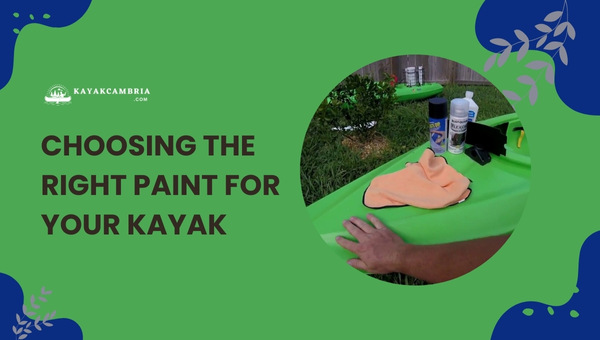
Before diving into paint options, it’s crucial to mention that kayaks can be made of different materials such as polyethylene, fiberglass, and composite. Each material requires a specific type of paint or primer to achieve the best results, so identifying your kayak’s material is the first step.
Here’s a quick guide to finding suitable paints for different kayak materials:
1. Polyethylene
- Krylon Fusion
- Rust-Oleum Painter’s Touch 2X
2. Fiberglass
- Epoxy paint
- Two-part polyurethane paints
3. Composite
- Polyurethane-based paints
- Acrylic-based paints
When painting a polyethylene kayak, it can be challenging to find paint that adheres well since the surface is smooth and doesn’t provide the best grip. However, Krylon Fusion and Rust-Oleum Painter’s Touch 2X have proven to be effective options due to their ability to bond well with plastic surfaces.
For fiberglass kayaks, epoxy paint or two-part polyurethane paints are widely recommended, as they create a strong, long-lasting finish resistant to damage from water, sunlight, and abrasion. While epoxy paint offers great adhesion, two-part polyurethane paints are known for their exceptional flexibility and durability.
Lastly, composite kayaks can be painted using polyurethane or acrylic-based paints. Polyurethane-based paints are more rugged, offering better protection against sunlight and abrasion, while acrylic-based paints are known for their water resistance and ease of application.
No matter which paint you choose, don’t forget to use a suitable primer for your kayak’s material. Here’s a list of recommended primers for different kayak materials:
- Polyethylene – Paintable Plastic Primer
- Fiberglass – Epoxy primer
- Composite – Acrylic or polyurethane-based primer
Now that you’re familiar with the best paint options for your kayak, remember to follow the manufacturer’s instructions for application, drying times, and any necessary surface preparation. Proper surface preparation is crucial to ensure a smooth and successful painting process.
Prepping Your Kayak For Painting
Before diving into how to paint a kayak, it’s essential to prep it correctly to ensure the paint job lasts and looks professional. I’ll guide you through the key steps during the prepping process.
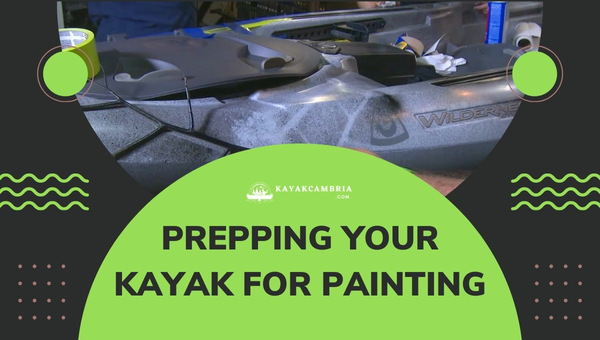
First and foremost, you’ll want to clean the kayak thoroughly. Any dirt, grime, or contaminants on the surface can impede the paint from adhering properly. Here are the steps to follow:
- Rinse the kayak with a hose to remove any loose dirt.
- Use a sponge or cloth and a gentle boat or plastic cleaner for more stubborn dirt. Avoid using harsh chemicals or abrasive materials that could damage the kayak’s surface.
- Rinse again and let the kayak dry completely.
Once you have a clean and dry kayak, it’s time to move on to the next phase: sanding. Sanding the surface will not only remove any rough spots but also give the paint a better surface to adhere to. Use fine-grit sandpaper (180-220 grit) and sand the entire kayak, working in small sections. Be sure not to sand too hard, as you don’t want to compromise the kayak’s structural integrity.
Following the sanding process, you’ll want to wipe the kayak down with a tack cloth or a damp, lint-free cloth to remove any sanding dust. It’s crucial to eliminate any debris left behind to ensure a smooth paint job.
Now that your kayak is prepped, it’s time to consider masking off the areas of the kayak you don’t want to paint. Use painter’s masking tape to cover any parts you want to keep paint-free, such as logos, handles, or hardware. Be sure to press the tape down firmly to create a tight seal and prevent any paint from bleeding through.
Selecting A Design And Color Scheme
Before diving into the process of how to paint a kayak, it’s important to choose a design and color scheme that suits your taste and needs. A well-thought-out design can not only enhance the overall appearance of your kayak but also make it more functional and recognizable. In this section, we’ll go over some key factors to consider while selecting a suitable design and color scheme for your kayak.

First, consider the purpose of your kayak. Are you planning to use it primarily for fishing, touring, or recreational paddling? By understanding its primary function, you can tailor your design accordingly. For instance, if you’re an avid angler, you might want to incorporate camouflage colors or fish graphics to blend in with your surroundings. On the other hand, touring kayakers may opt for more streamlined and minimalist patterns.
Next, think about your personal style and preferences. Remember that your kayak will be an extension of yourself, so choose colors and patterns that reflect your personality. Here are a few popular designs to draw inspiration from:
- Solid Colors: Ideal for those who prefer a simple and clean look. With a wide range of colors available, you can easily match your kayak to your other gear.
- Geometric Patterns: For a more intriguing appearance, explore various shapes and sizes, such as stripes or gradients.
- Nature-Inspired Designs: Connect with the outdoors by incorporating images of wildlife, landscapes, or ocean waves.
- Custom Graphics: Make your kayak unique with your favorite brand logos, quotes, or other personalized elements.
Now that you have an idea of what design and colors you’d like, it’s crucial to choose the right paint materials. As a general rule, select water-resistant paint that’s specifically designed for use on kayaks or other marine vessels. This will ensure that your design remains vivid and durable, even when faced with harsh conditions on the water.
When selecting a design and color scheme for your kayak, keep in mind its primary function, your personal style, and the appropriate paint materials. Don’t be afraid to get creative and think outside the box – your kayak can be a reflection of your individuality and passion for outdoor adventure. With an attractive and well-chosen design, you’ll be one step closer to mastering the art of how to paint a kayak.
Making A Template For Your Design
When it comes to how to paint a kayak, designing a template for your desired paint job is a crucial step. I’ve found that having a solid plan in place will save time and effort, ensuring the final look meets my expectations. In this section, I’ll guide you through creating a template to help you achieve a great paint job for your kayak.
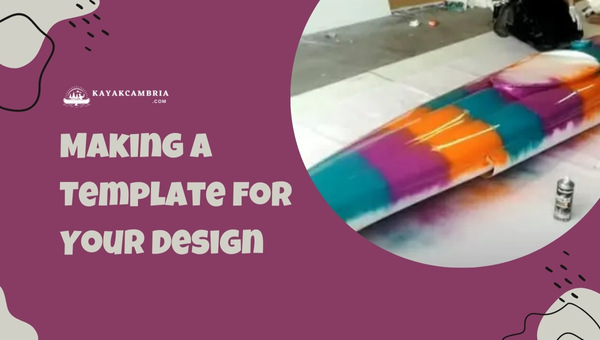
First, decide on what type of design you want for your kayak. It could be a specific pattern, a few abstract shapes, or even an intricate image. To make things simpler, I recommend breaking your design down into smaller components. This will help not only in creating the template itself but also in painting the kayak later.
Next, gather the necessary materials to make a template. You’ll need:
- Graph paper or a large sheet of paper
- Pencils and erasers
- Measuring tape
- Scissors or a cutting tool
- Transparent tape (optional)
Now let’s create the template:
- Measure your kayak: Measure the length, width, and height of the kayak, as well as any other specific areas you want to paint. Make note of these dimensions, as they will be essential when transferring your design onto the template. For instance, if your kayak is 10 feet long and 2 feet wide, you’ll want to ensure your template reflects those proportions.
- Draw the kayak’s shape on paper: On your graph paper or large sheet of paper, draw an outline of the kayak’s shape using the measurements you’ve taken. This will serve as the base for your design. Make sure to include any additional features, like handles or hatches, on the outline.
- Sketch the design: Using your chosen design idea, begin sketching it onto the kayak’s outlined shape. Don’t worry about being too precise at this stage; it’s more important to get the overall idea and positioning right. If you’re working with a complex design, consider using different colors to represent different elements.
- Finalize the design: Once you’re happy with your design, trace over it with a darker pencil or pen. This will create clean, bold lines, making it easier to cut and transfer the template onto the kayak.
- Cut out the template: Carefully cut out your design from the paper using scissors or a cutting tool. If your design includes separate components, cut each piece out separately. You can use transparent tape to hold the pieces together when transferring them to the kayak.
Congratulations! You’ve now created a template for your kayak design. In the following sections, I’ll discuss how to prepare your kayak for painting and apply the template, ensuring a smooth and professional-looking paint job.
Masking Off The Design Area
When the time comes to create a custom look for your kayak, knowing how to paint a kayak properly makes all the difference. One crucial step in the process is masking off the design area, ensuring a clean and professional appearance when completed. I’ll break down this essential aspect of the process in a few paragraphs for your convenience.
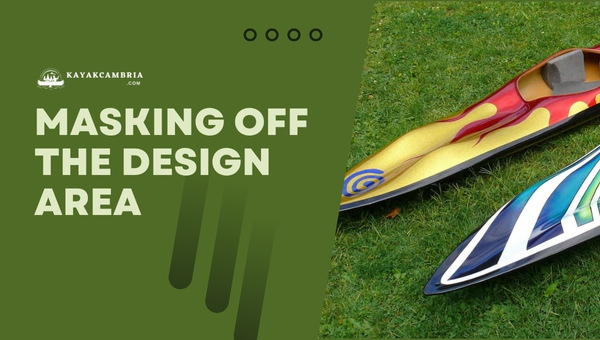
Before starting, it’s important to gather the necessary materials, which include:
- Painter’s tape
- Craft paper or plastic sheeting
- Scissors
- Clean cloth
- Alcohol or wax and grease remover
First, clean the kayak thoroughly by wiping it down with a clean cloth dampened with alcohol or a wax and grease remover. This step is vital as it allows the painter’s tape to adhere properly and prevents potential contamination in the design area.
Next, map out your design by applying painter’s tape to the kayak’s surface. It’s best to start with the larger sections and gradually work on the smaller, more intricate details. Take your time placing the tape, as accuracy is key. Remember to press down firmly on the edges of the tape to create a tight seal and avoid paint bleeding underneath it.
Once the design is outlined with painter’s tape, cover the remaining sections of the kayak with craft paper or plastic sheeting. This step protects the kayak from overspray and accidental drips during the painting process. Use the scissors to cut out any necessary shapes in the paper or sheeting, ensuring it lays flat against the kayak. Secure the paper or sheeting to the painter’s tape for a snug fit.
At this point, the kayak is ready for that brand-new color or intricate design you’ve been dreaming of. With the design area cleanly masked off, you can confidently move forward in the process, knowing your finished product will be nothing short of impressive.
Applying Primer To The Kayak
Before we dive into how to paint a kayak, it’s crucial to discuss one of the most essential steps – applying primer. A well-applied primer provides a solid base and facilitates better adhesion for the paint, ultimately increasing the quality and durability of your paint job.

Preparation is key when working with primer. To start, I’ll thoroughly clean the kayak’s surface, removing dirt, grime, and any peeling paint. Using a mild soap and water solution should do the trick. Afterward, I’ll rinse and dry the kayak before lightly sanding the surface to create a rough texture. This step improves the primer’s adherence to the kayak.
Next, it’s essential to mask off areas that I don’t want to be covered with primer. These may include:
- Deck hardware
- Seat brackets
- Seals or gaskets
- Handles or straps
I’ll use painter’s tape and plastic sheeting to keep these areas protected during the priming process.
When I’m ready to apply the primer, I’ll first choose the right type for my specific kayak material. Here are some common materials and compatible primers:
| Kayak Material | Primer Type |
| Polyethylene | Plastic Adhesion Promoter |
| ABS | Plastic Primer |
| Composite | Epoxy Primer |
Once the appropriate primer is selected, it’s time to mix it. To ensure a smooth and even finish, I’ll mix the primer according to the manufacturer’s instructions. Mixing ratios can vary depending on the brand, so always be sure to consult the product label before mixing.
Now comes the most important step – applying the primer. I’ll use a paintbrush or a foam roller to evenly coat the kayak’s surface with a thin layer of primer. For even coverage, I would recommend applying multiple thin coats rather than a single thick one.
After each coat, I’ll wait for it to dry before applying the next. Most primers take about 30 minutes to 1 hour to dry, but drying times can vary by brand and environmental conditions, so it’s best to check the label for accurate drying times.
Once I’ve applied the necessary coats and the primer is completely dry, it’s essential to lightly sand the surface one final time. This step removes any imperfections and creates a smooth, even surface for the paint to adhere to.
By following these steps, I’ll have a perfectly primed kayak that’s ready to be painted. Applying primer to the kayak properly ensures a lasting and appealing paint job, taking me one step closer to enjoying my beautifully painted kayak on the water.
Spraying Or Brushing On The Paint
When it comes to painting your kayak, you might find yourself wondering which method is best: spraying or brushing on the paint. I’m here to help you make an informed decision by highlighting the pros and cons of each method, as well as providing a few tips to ensure a smooth application.
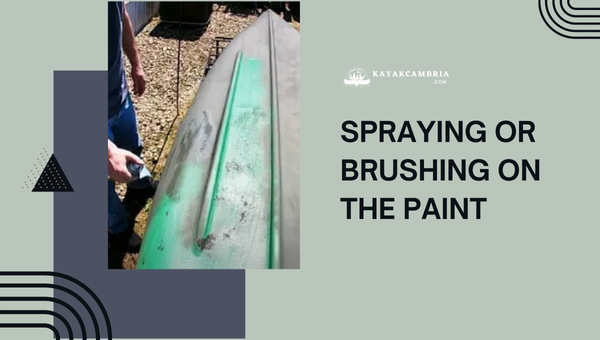
First, let’s consider the advantages of spraying the paint onto your kayak.
- It provides an even coat and professional finish.
- Spraying allows for a quicker application, especially on large surfaces.
- It’s easier to cover hard-to-reach areas.
However, there are also some drawbacks to spraying:
- Requires additional equipment, such as a spray gun and compressor.
- A higher risk of overspray or paint drift, which can be messy.
- It might be more challenging to control the paint’s thickness.
On the other hand, brushing the paint onto your kayak also comes with its benefits:
- Minimal equipment needed – just a brush and your paint.
- More control over the paint’s thickness and application.
- It’s generally a less expensive method.
Brushing also has its shortcomings:
- It can be time-consuming, particularly on larger surfaces.
- There’s a risk of leaving brush strokes on the surface.
- It might be difficult to achieve an even, professional finish.
To decide which method is best for you when learning how to paint a kayak, think about your budget, the equipment available to you, and your level of experience with painting. If you’re looking for a quicker application with a smoother finish, you may prefer the spraying method. Alternatively, if you’d prefer a more controlled and affordable option, brushing might be the better choice.
In any case, it’s vital to follow these essential tips when painting your kayak:
- Prepare the surface: Clean and sand the kayak’s surface before applying paint to ensure proper paint adhesion.
- Use the appropriate paint: Marine-grade paint is specifically designed for boats and will provide the best results.
- Apply multiple coats: Two or three thin coats are ideal for a smooth, even finish.
- Allow ample drying time: Follow the manufacturer’s recommendations for drying times between coats and before using the kayak.
Whatever method you choose, remember that practice makes perfect. If you’re uncertain, test your preferred method on a small, inconspicuous area before committing to your entire kayak. With patience and attention to detail, you’ll have a beautifully painted kayak that you can be proud of!
Allowing Proper Dry Time
When learning how to paint a kayak, it’s crucial to allow the proper dry time between stages. This ensures that the paint adheres properly and provides a smooth, long-lasting finish. In this section, I’ll cover the importance of dry time and offer some tips on how to ensure your paint dries efficiently.
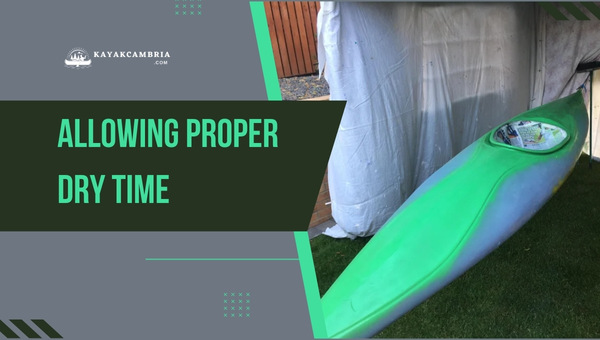
The first step in the process is primer application. Primer prepares the surface for paint, ensuring better adhesion and durability. After applying primer, it’s essential to let it dry for a full 24 hours before moving on to the next step.
Next, you’ll move on to the painting process. When applying the paint, you’ll need to be patient and allow plenty of dry time between coats. I recommend waiting at least 24 hours between each coat of paint to ensure proper drying, avoiding any blemishes or uneven surfaces. In some cases, especially in more humid environments, you might need to wait even longer for the paint to completely dry.
Here’s a helpful breakdown of average drying times for various paint types:
| Paint Type | Drying Time (Hours) |
| Water-Based | 4-6 |
| Oil-Based | 6-8 |
| Epoxy | 12-24 |
Keep in mind that these are average times, and specific products might have different recommendations. Always follow the manufacturer’s guidelines on the paint can for accurate drying times.
To expedite drying and ensure a smooth finish, consider the following tips:
- Apply thin, even coats of paint: Thicker coats will take longer to dry and can result in a less even finish.
- Use a hairdryer or heat gun: Applying low heat to the painted surface can help speed up the drying process. Be careful not to apply too much heat or for too long, as this can cause the paint to crack or blister.
- Keep the kayak in a well-ventilated area: Good air circulation helps paint dry more quickly, so try to keep your kayak in a spot with plenty of airflows.
- Avoid painting in extreme temperatures or high humidity: Excessive heat or humidity can lengthen the drying process and cause paint problems.
Sealing Your Kayak’s New Paint Job
After learning how to paint a kayak, it’s crucial to seal the new paint job to ensure it lasts longer and maintains its vibrant appearance. In this section, I’ll walk you through the process of sealing your kayak’s new paint job, so it stays protected from the elements and holds up against normal wear and tear.
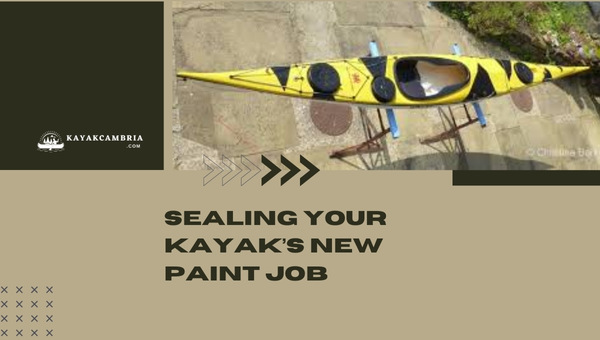
Before diving in, make sure the paint has fully dried. Depending on the type of paint used, this may take anywhere from 24 hours to several days. Be patient, as rushing this step can lead to a weak seal and, ultimately, a paint job that doesn’t last.
Once the paint is completely dry, it’s time to start sealing. Here are the key steps to follow when sealing your kayak’s new paint job:
- Choose a suitable clear coat: Pick an appropriate clear coat for your kayak material. For example, if you’ve got a plastic kayak, opt for a clear coat designed specifically for plastic surfaces. If you’re not sure what to use, consult your paint’s label or ask for advice at your local paint store.
- Clean the surface: Before applying the clear coat, ensure your kayak is clean and free from any dust or debris.
- Apply the clear coat: Using a spray can or paintbrush, apply a thin, even layer of clear coat to the entire surface of your kayak. Make sure to follow the manufacturer’s instructions for optimal results.
- Allow the clear coat to dry: Give the clear coat ample time to dry. This could take anywhere from a few hours to several days, depending on the product used and environmental factors.
- Inspect your work: Check the kayak for any areas that might need a second coat, paying close attention to spots where paint could be exposed to water.
- Sand and apply additional coats if necessary: If needed, lightly sand the surface (use fine-grit sandpaper) and add another coat of clear sealant. Repeat this process until you achieve a consistent and durable finish.
Some quick tips for sealing your kayak’s new paint job:
- Always wear proper safety equipment (gloves, mask, eye protection) when working with chemicals.
- Work in a well-ventilated area to avoid inhaling harmful fumes.
- Keep a damp cloth nearby to clean any drips or spills quickly.
With these steps in mind, you’ll be able to effectively seal your kayak’s new paint job and help it withstand the test of time. Don’t forget that proper maintenance also plays a big role in extending the life of your kayak’s paint, so take care of it with regular cleaning and careful storage.
The Final Touches and Conclusion
After going through each step of the “how to paint a kayak” process, it’s time to wrap things up by adding the final touches and delivering a stunning finished product. I’ll break down this final section into manageable paragraphs to ensure a clear understanding of each aspect.
The first important aspect to consider is clear coating. It’s essential to apply a clear protective coating after painting a kayak to seal in the color and protect it from the elements. You can choose between various types of clear coatings, such as:
- Polyurethane
- Spar varnish
- Epoxy resin
Taking the time to apply a clear coat will provide an added layer of protection against sun, water, and abrasion, ultimately prolonging the life of your paint job.
Next, it’s helpful to inspect and fine-tune the details. Once the paint and clear coat have dried, carefully inspect your kayak for any imperfections, like drips or uneven areas. If needed, gently sand away any problem spots and apply another coat of paint, followed by a clear coat. These extra steps can make the difference between a good paint job and a fantastic one.
Don’t forget about adding unique and personal touches to your kayak as well. Consider incorporating decals, stickers, or even painted designs that reflect your personal style or interests. This step allows you to make your kayak truly one of a kind and a reflection of your personality.
In summary, the process of painting a kayak involves several steps, from preparation and priming to applying the paint and adding the final touches. By carefully following each stage, you can achieve a professional-looking result that adds both aesthetic appeal and functionality to your kayak.
As you embark on your next kayaking adventure, you’ll be able to appreciate the fruits of your labor and take pride in your newly customized vessel.

